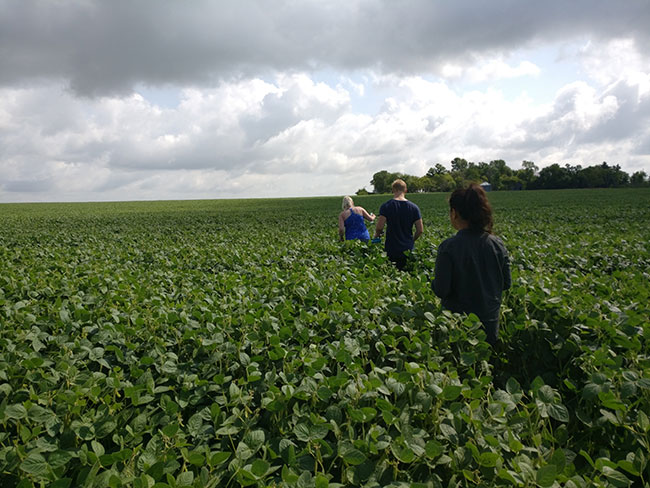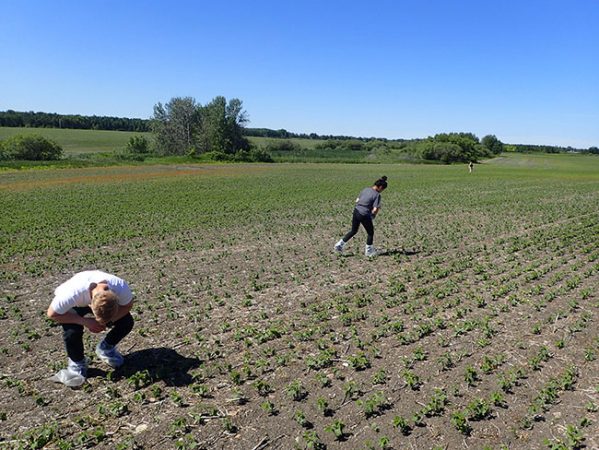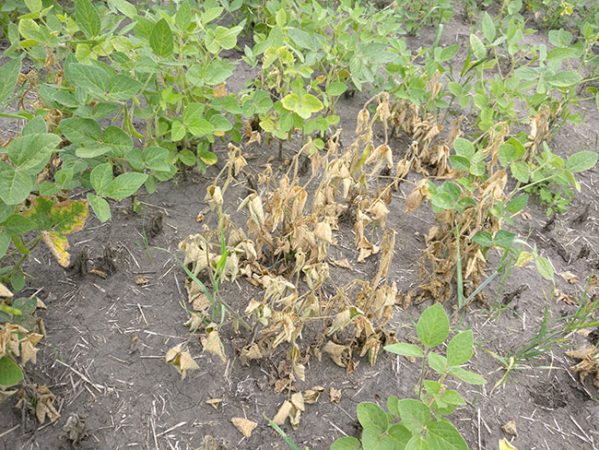
Features
Soybeans
A complete leaf disease survey in Manitoba soybeans
DNA sequencing has led to the discovery of emerging diseases and development of practical diagnostic tools.
September 15, 2019 By Carolyn King
 Photo courtesy of Gustavo Díaz Cruz, Brandon University.
Photo courtesy of Gustavo Díaz Cruz, Brandon University. Identifying a crop disease based on visual assessments of symptoms or laboratory can sometimes be tricky. For instance, the symptoms might be unfamiliar to the surveyors because the disease is new to the area or very rare, or the symptoms might look really similar to another disease. In a recent project, Brandon University’s Bryan Cassone used DNA sequencing for an accurate look at the foliar diseases infecting Manitoba soybean crops.
As a result of this research, Manitoba soybean pathologists, agronomists and growers now have a comprehensive list of the current foliar pathogens, including some that have never before been reported in Manitoba. Plus, the sequencing technology has enabled Cassone and his research group to develop new tools for improved diagnosis of soybean diseases.
Cassone targeted foliar diseases in this project because he knew they had the potential to become a very serious issue for Manitoba soybean growers. “I worked for four years as a scientist at Ohio State University in the midst of the soybean belt in the U.S. I saw how devastating foliar disease could be to soybean yield. I’ve seen it wipe out entire fields. So to me, it was a huge concern,” explains Cassone, an associate professor of biology at Brandon.
“Also, because soybean is a relatively young crop in Manitoba, we had very little knowledge of the foliar diseases that are actually infecting soybean here.”
At Ohio State, Cassone had worked with next-generation DNA sequencing – high-throughput technologies that enable sequencing of millions of pieces of DNA in a very short time. He says, “Next-gen sequencing is extremely sensitive and accurate, and a really powerful tool for detecting pathogens.”
The Manitoba Pulse and Soybean Growers (MPSG) funded Cassone’s project, which ran from 2016 to 2018.
Frogeye and other emerging diseases identified
The project’s major objective was to identify the pathogens causing emerging and established foliar diseases in Manitoba soybean crops. Identification of emerging diseases is important for alerting growers and agronomists to new disease concerns, and it can prompt researchers to work on methods for combatting these diseases, like breeding resistant varieties and testing control products under local conditions.
Cassone’s research group worked with Manitoba Agriculture and MPSG to collect leaf samples from fields across the province’s soybean growing areas in 2016 and 2017. “We surveyed twice per year, once early in the growing season and once later in the growing season, because the pathogen composition can change quite a bit,” Cassone explains.
In each of the surveys, they visited between 20 and 25 fields. “There were three or four surveyors, depending on the field. At about three different places in the field, they used a 100-metre, Z-scheme sampling regime where they would collect a sample from every plant that appeared to have a foliar disease symptom.” If they found identical disease symptoms, they would only take one leaf from one plant. “We tried to get a good representation of all the disease symptoms that we saw, and not overlap with the same one over and over again.”
Cassone’s lab conducted the DNA analysis of each leaf. That analysis determined all of the organisms present in and on the leaf – the leaf itself, all the microbes, and any insects and other organisms that happened to be there.
He says, “This DNA work results in literally millions and millions of little pieces of DNA. We use our computers to piece them together; so this piece of DNA is the genetic code for soybean, this piece is the genetic code for microorganism one, this piece is for microorganism two, and so on. We literally piece together their entire genetic code or a good piece of their genetic code to determine which microorganisms are actually present in that leaf.”
This approach resulted in the detection of diverse foliar pathogens – including fungi, bacteria, viruses and oomycetes – that currently infect Manitoba soybean crops. As expected, some of the diseases were already well known in Manitoba, such as Septoria brown spot, bacterial blight, and downy mildew. But some had never before been reported in the province’s soybean crops, confirming the value of using DNA analysis for identifying emerging diseases.
“Frogeye leaf spot is definitely the worst of the foliar diseases that we identified that were previously unreported,” Cassone says. Frogeye can result in serious yield losses under the warm, humid conditions that favour this disease.
“In 2016, conditions were really wet, and we found frogeye in quite a few places. In 2017, it was quite dry, and we found frogeye at very low abundances compared to 2016. So the hope is that the disease stays contained.” However, he notes that the widespread occurrence of frogeye in 2016 suggests the pathogen has been present in Manitoba for some years.
“Another of the previously unreported diseases was soybean bacterial pustule. It can be a problem for soybean, but we found it in small frequencies and it is rare to cause significant yield loss,” he says.
“We also found several viruses that had never been reported in Manitoba soybean, like alfalfa mosaic virus, tobacco necrosis virus, and bean yellow mosaic virus. But typically these viruses are not major problems for soybean.”
Frogeye and the other newly detected diseases have been incorporated into the annual disease surveys conducted by Manitoba government pathologists and agronomists.
Surprising numbers of residual pathogens
“Another thing we found using this powerful approach was a whole bunch of residual pathogenic fungi and bacteria that had infected the previous crop,” Cassone says. He explains that a residual pathogen is one that remains from an earlier crop in the rotation. For instance, if you grew corn before your soybean crop, then the pathogens that infected your corn crop could still be present in the soybean field, even though they aren’t actually able to infect soybean plants.
Cassone points out that the high number of residual pathogens detected through the DNA work has implications for crop rotation decisions. For instance, if you plant the same crop two years in a row or if you have a two-year rotation, then you could have severe disease problems because the pathogens remaining from the earlier crop are still literally moving around in the field.

Some foliar diseases have the potential to cause serious yield impacts in soybean. Photos courtesy of Gustavo Díaz Cruz.

The surveyors collected samples of diseased soybean leaves twice a year, including once early in the growing season.
Co-infections very common
The project’s second objective was to evaluate the incidence of co-infections – where more than one foliar pathogen was infecting the same plant – and to look for pathogens that might be acting together to increase disease.
The ability to accurately identify co-infecting pathogens could be important in deciding what control measures to apply, but Cassone says co-infections are not usually determined in disease surveys. “The vast majority of surveys in North America for soybean and other crops are mostly visual assessments with a little bit of culturing. However, it is difficult to detect more than one pathogen if you are just looking at symptoms in the field. And even with culturing, you rarely detect all of them.”
In contrast, next-gen sequencing identifies all the co-infecting pathogens.
“The major take-away message from this co-infection work is that most diseased soybean plants are infected by multiple microorganisms,” Cassone says. He suspects that this is true for all crop types.
Through analysis of the co-infection data, Cassone has identified associations between certain pathogens. “For example, particularly in 2016, more times than not when a plant was infected by Alternaria, a fungus that causes a type of leaf spot, the plant would also be infected by frogeye, usually to a little lesser degree.”
According to Cassone, not a lot is known yet about how some pathogens act together synergistically to increase the likelihood of disease. The co-infection associations identified in this project might be an area for future research to better understand disease development and perhaps improve control measures. For instance, if pathogen A can only infect a soybean plant if pathogen B has already infected that same plant, then maybe control measures could emphasize prevention of the spread of
pathogen B.
Handbook for identifying co-infections
The project’s results also clearly showed that it is extremely challenging to accurately diagnose co-infections based on visual assessment of symptoms. “During the field surveys, every time somebody collected a sample, they would assess what they thought it was infected with. It turned out that they were correct less than eight per cent of the time,” Cassone notes.
He adds, “We have found up to five pathogens co-infecting. A lot of times with the co-infections, we see really weird symptoms, and it seems like they can’t be from a pathogen that we know. Some of the leaves actually look like they might almost have a nutrition deficiency because they have an appearance that is very uncharacteristic of a disease.”
Although next-generation sequencing is great for identifying co-infecting pathogens, Cassone explains that using this technology every year in annual disease surveys is not practical at present because it is expensive and requires some special expertise, and it can take roughly six to 10 weeks to get the results.
As a result, Cassone added a third objective to his project: development of an extension disease handbook to help in identifying co-infections.
“In this handbook, we have catalogued about 200 different soybean leaves and identified which diseases they are infected with,” he explains. “The hope is that when agronomists and pathologists are carrying out their annual disease surveys, they can use our leaf guide as a reference. If they see very similar symptoms, they will have a very good idea of what might actually be infecting their plants.”
Cassone is currently finalizing the handbook. Once it goes through the scientific peer review process, he plans to make the publication available to soybean agronomists and pathologists.
A new quick, accurate diagnostic tool
“Even though the survey using next-gen sequencing is over, the results are feeding into the development of other methods that are faster and more cost-efficient and still very sensitive,” Cassone notes.
“We are developing a PCR-based diagnostic that identifies our most important pathogens at the same time. With this, we can analyze a sample in less than a day. It is accurate and sensitive, but instead of getting the exhaustive list of pathogens that is produced with next-gen sequencing, we are limited to a few pathogens from a given tissue, such as a leaf or stem.”
PCR is a DNA-based technique, and creation of this PCR tool was only possible because of the DNA sequence information that Cassone and his group built through the project.
In addition, their DNA work identified which particular foliar pathogens are the most important ones to target with this diagnostic tool. Through a separate study, they conducted some preliminary sequencing work with soybean stem disease samples, so they have an initial assessment of which stem pathogens to target.
The four foliar pathogens identified by the tool are: Septoria glycines (brown spot), Peronospora manshurica (downy mildew), Alternaria alternata (leaf spot) and Cercospora sojina (frogeye). The four stem pathogens are: Sclerotinia sclerotiorum (white mould), Diaporthe phaseolorum (stem canker), Phytophthora sojae (root rot) and Phialophora gregata (brown stem rot).
“We have noticed that it is usually these [eight] pathogens that are the most widespread and the most likely to be the greatest risk for soybean foliar tissue and stem tissue. The other pathogens are really rare or not really important to growers.”
The project has also generated some findings that are mainly of scientific interest. For instance, Cassone has published the first-ever report of brome mosaic virus infection in soybean. “Brome mosaic virus infects grasses, but it is a really weird virus because it is also known to infect some [broadleaf] plants such as beets and cucumber. Before our study, brome mosaic was not known to infect soybean. Now we have proven that it does infect soybean. It’s not likely to be significant for soybean growers, but on a biology level it is quite interesting.”
He also notes, “To show how sensitive this technology is, we were actually able to find a virus that infects the pathogen that causes white mould. We were able to build the genome of this virus, and we are sending that out for publication.” Along with being pretty cool from a scientific perspective, this finding might possibly turn out to have some implications for the control of the white mould pathogen, which also causes disease in many other broadleaf crops.
Potent technology, practical benefits
Through the use of DNA sequencing, Cassone and his group have generated some valuable outcomes for Manitoba soybean growers. The researchers have detected several foliar diseases that have never before been reported in Manitoba soybean crops, including some like frogeye that are important additions to the annual disease surveys. And they have developed a rapid, accurate, low-cost method for identifying key foliar and stem pathogens.
The project’s findings have also underlined the significant issue of co-infection. In response, Cassone and his group have developed a handbook to help soybean agronomists, pathologists and growers with the very difficult task of identifying co-infecting foliar pathogens.
Down the road, technological advances might make next-gen sequencing a more practical tool to use every year in annual disease surveys in soybean and other crops. For now, Cassone suggests that it might be added to annual surveys every now and then, especially for newer crops like soybean.